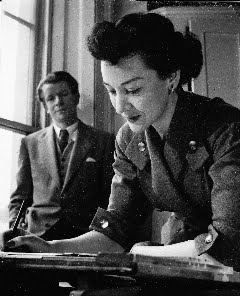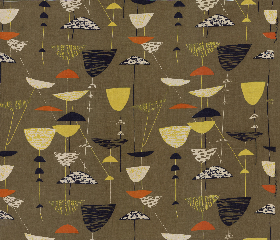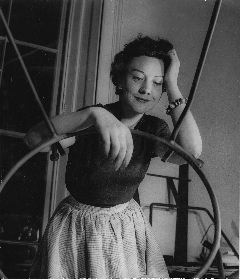Celebrating Robin and Lucienne Day
 |
| courtesy of Design Onscreen |
It’s time for Robin and Lucienne Day to have their moment in the light. Too-long regarded as the Charles and Ray Eames of the UK, their individuality and accomplishments will finally receive due credit with the release of a new film, “Contemporary Days,” followed by the opening of an exhibit next year at the Pallant House Gallery in the UK. Embarking on their prolific careers in furniture and textile design during the turmoil of post-World War II England, the young married couple found themselves in a challenging environment in which to promote design as social vision; the country had been heavily bombed and was without basic materials well into the mid-1950’s. But the Days shared, among other things, a deep optimism for modernism’s potential to help steer the war-torn country in a new direction.
Contemporary Days: The Designs of Lucienne & Robin Day from Design Onscreen on Vimeo.
The film, directed by Murray Grigor, tells the Day’s story in a straight-forward manner through several interviews with people who worked with them. There are more recordings of Lucienne Day, so her voice is more prevalent, but the viewer doesn’t sense that either she or Robin dominated. While the Eames’ collaboration was largely represented through Charles as the spokesperson, the Days pursued their own interests independently and had separate studios right next to each other. Despite this autonomy, Robin’s furniture and Lucienne’s fabrics work well together because of their shared vision rooted in the education (at the Royal College of Art) and wartime experience they shared. Both of them wanted to shape Britain’s modernity after the war.
Not surprisingly, in this post-war context, excess ornament seemed pointless, so Robin’s minimal furniture felt right for the moment. Many of his designs were successfully produced for the low-cost market, in particular his stacking wood, and later, plastic chairs. But when permitted a bit of luxury his work could be almost whimsical, like his some of his pieces for the Festival Hall in 1951. The wood arms feel like wings that might lift the chair into space.
Looking back at Lucienne’s textiles, many designed for Heal’s Department store, we find beautifully drawn and colored patterns. The repeats are subtle and the designs look timeless. Some of them have been reintroduced by Classic Textiles, and Unica Home carries modest, limited edition tea towels.
 |
| Calyx textile courtesy of Jill A. Wiltse and H. Kirk Brown III Collection of British Textiles |
The executive producers of the new film, Denver-based collectors H Kirk Brown and Jill A Wiltse, are also loaning their extensive collection for the Pallant Gallery exhibit next year. Their effort and commitment to celebrating the couple’s work have been instrumental in giving the Days this moment.
While the Days were a charismatic and successful couple – with their good looks, beautiful voices, and winning competition entries – they more importantly shared a profound talent and a desire to create change in a challenging time. They had faith in the future. In our own age, perhaps environmental awareness and more efficient technologies may renew the power of design to steer us in a more sustainable direction. The talented young optimists are somewhere among us.
Coda:
Robin Day passed away on November 9th at his home in Chichester, England.
More Information:
The movie:
www.designonscreen.org
The exhibit in 2011:
www.pallant.org.uk/exhibitions/forthcoming/main-galleries/robin-and-lucienne-day/robin-and-lucienne-day
The textiles:
http://www.classictextiles.com/day.html
The tea towels:
http://www.unicahome.com/p40106/limited-edition-tea-towels-designed-by-lucienne-day.html
The interview:
http://www.wallpaper.com/art/the-days-interview/2915
 |
| courtesy of Design Onscreen |